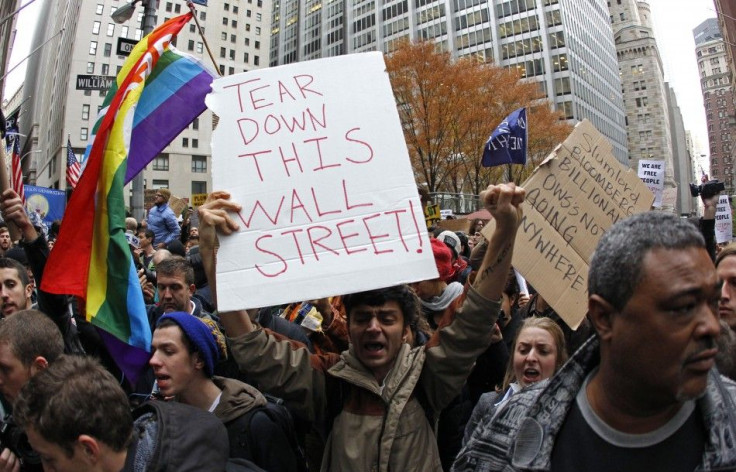Occupy Wall Street Rallies, Undeterred by Zuccotti Park Eviction

Occupy Wall Street may have lost Zuccotti Park, but a Thursday morning march on Wall Street proceeded with undiminished enthusiasm.
Late Thursday morning about 11 a.m. EST, several hundred protestors returned to Zuccotti Park, taking down baricades to chants of Whose park? Our park! as they stormed back in. Police did not immediately react.
Prior to the 11 a.m. baricade push, a small crowd gathered in the park, the movement's base camp until they were forced out in a middle of the night police raid on Monday, and that was a far cry from the larger masses that had previously assembled there before big rallies. But the typical preparations were still on display, including instructions on what to do if arrested and a woman advising people to write the phone number for the National Lawyers Guild on their arms.
There were signs that the march was more fragmented than previous efforts that began with people massing in Zuccotti Park. A woman handed out green ribbons, explaining that they corresponded to one of three separate marches that had been formulated the night before -- green, she said, indicated people who didn't want to be arrested.
Activist: Zuccotti Park Not Essential to Movement
The principles of our movement are about decentralization and autonomy, and it's not as if the movement has official membership, said Mark Bray, a member of the Occupy Wall Street press working group. He added that Zuccotti Park wasn't essential to the movement, noting that this is not about one square in lower Manhattan. This is about changing the priorities of the country.
Protesters wove their way through the streets surrounding Wall Street, and surging towards the financial epicenter until police barricades forces them to seek an alternate route. Among them was Ray Lewis, a 60-year-old retired police captain from Philadelphia, who was dressed in a crisp blue uniform. He would be arrested later in the morning for obstructing traffic.
They're victims just like everyone else, Lewis said of the New York police officers deployed throughout lower Manhattan. They don't know it but when their healthcare is taken away, their pensions are taken away, their pay is cut, they will.
One arm of the march became locked in a standoff with the police at the intersection of Pine and Nassau, the New York Stock Exchange looming a block away. Police officers began arresting protesters, including Lewis, as a thicket of cameras sprung up around them and protesters chanted Shame!
Protesters were steadily pushed back onto the sidewalks by officers in blue helmets with visors as another officer warned through a megaphone that staying in the street would result in arrest. In a poignant moment, protesters began singing the national anthem.
Critics have continually questioned the motives and goals of Occupy Wall Street, and protesters held signs targeting grievances that ranged from foreclosures to student loans.
Daniel J. Barach, who identified himself as a Harvard MBA who had once run a successful hedge fund, came dressed in khakis and a blue blazer and wore a large sign with the message, Stop tax breaks for hedge fund managers written across it.
A lot of people try to stereotype the movement, said Barach. It should be about the message, not about the messengers.
UPDATE
Jubilant protesters returned to Zuccotti Park in midmorning, joining a sizable contingent of protesters already gathered in the park and clashing with police. People began removing the barricades newly erected on the side of the park amidst chants of whose park? our park! It was unclear how many were arrested.
Afterwards the protesters held a rally in Zuccotti Park. They attempted to return to Wall Street but were turned back by a heavy police presence.
© Copyright IBTimes 2024. All rights reserved.











